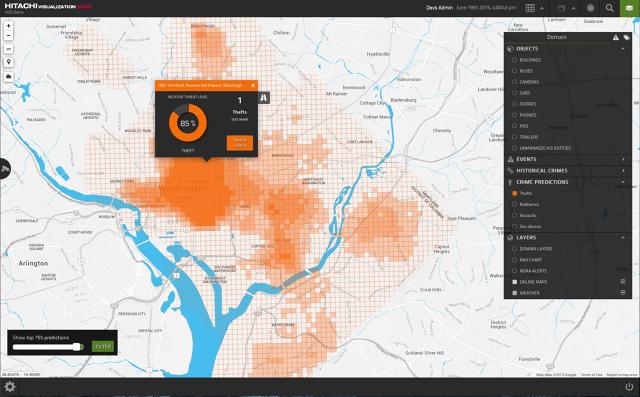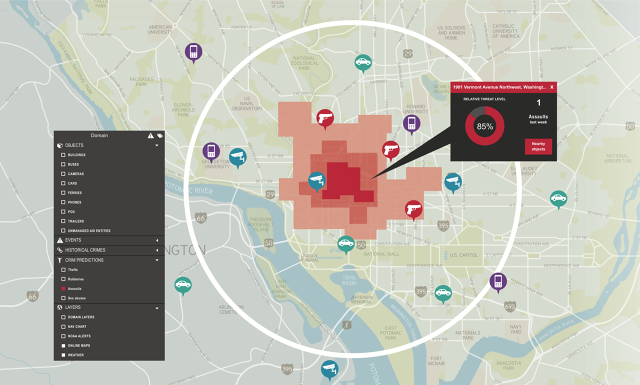Hitachi Says it may possibly Predict Crimes before They happen
no longer relatively Minority file, but monitoring the whole lot from climate to Twitter may be able to predict where and when crime will happen.
September 28, 2015
“indisputably the precogs have already considered this,” says Chief John Anderton (performed by Tom Cruise), head of Washington, D.C.’s experimental “Precrime” crime-prediction department in Minority file, the 2002 Steven Spielberg film according to Philip k. Dick’s 1956 short story (which can also be now a brand new Fox tv sequence).
of course, no person has discovered a trio of psychic mutant “precogs” who can unanimously foresee future crimes, however Hitachi nowadays offered a machine that promises to foretell the place and when crime is more likely to occur by means of ingesting a panoply of information, from historical crime information to public transit maps, from climate experiences to social media chatter. Hitachi says that “about half of a dozen” U.S. cities will sign up for a proof of idea take a look at of the technology beginning in October, and although Hitachi hasn’t yet named them, Washington, D.C. may neatly be on the record. it can be one of many dozen cities in the U.S. and Caribbean nations where the corporate already provides video surveillance and sensor systems to police departments with its Hitachi Visualization Suite. Hitachi professionals equipped a number of examples—even screenshots of the device—featuring D.C. in my conversations with them.

“we don’t have any precogs as part of our device,” says Darrin Lipscomb, cofounder of companies Avrio and Pantascene, which developed crime-monitoring tech that Hitachi later received. “If we decided that the precogs have been if truth be told somewhat correct, lets for sure use their predictions to feed into our version,” he says with good deadpan. What the brand new technology, referred to as Hitachi Visualization Predictive Crime Analytics (PCA), does have is the power to ingest streams of sensor and internet information from all kinds of sources.
It then applies what’s called desktop learning, the usage of the popular statistical software often called “R,” that crunches all this information in order to in finding patterns that people would leave out. “A human just can not handle when you get to the tens or a whole lot of variables that would impression crime,” says Lipscomb, “like climate, social media, proximity to schools, Metro [subway] stations, gunshot sensors, 911 calls.”
Let the info discuss For Itself
desktop studying is the new new section of synthetic intelligence. moderately than trying to design a ravishing electronic mind, pc scientists are now constructing enormous dispensed computing systems that analyze by way of sifting via fire hoses of information and ascertaining patterns or anomalies. This has become practical best recently with the advance of big, low cost information storage and processing capabilities, like Amazon web products and services (AWS), Microsoft Azure, and Hitachi’s own HDS cloud gadget–all of which Hitachi’s PCA can run on.
applying computing device learning is a giant change from conventional police dispatching, say each Lipscomb and Mark Jules, his cofounder at Avrio and Panatscene. (each at the moment are execs in Hitachi’s Public security and Visualization division.)
Hitachi is not the only company to supply public safety monitoring and prediction services and products. the place it claims to be distinctive is in its use of laptop finding out, in permitting the info to drive the predictions somewhat than moving into with any preconceived notions of what components are necessary.
traditionally, says Jules, police investigators construct crime-prediction fashions in line with their expertise with certain variables, like the positioning of schools or slang phrases for medicine that pop up on Twitter. They assign a weight to every variable in accordance with how necessary it appears to be. Hitachi’s device, he says, doesn’t require a human to determine what variables subject and how much. “You simply feed those information units,” says Jules. “And it decides, over a few weeks, is there a correlation.”
Social media plays a massive role in predicting crime, they are saying, bettering accuracy with the aid of 15%. Hitachi makes use of pure language processing: the ability of a computer to ingest and be mindful colloquial textual content or speech.
applying what’s known as a latent Dirichlet allocation, the gadget can sift thru each tweet tagged to a particular geography to search out significant phrases that point out what’s going down. “Gangs, for example, use these totally different keywords to perhaps meet up or perform some action,” says Lipscomb. “I do not know what that keyword is…but with our method we will in truth pick out something which is extraordinary, like anyone’s the usage of an off-matter word, and the usage of it in a very tight density or proximity, and that’s going to get a bigger weight.”
One thing social media signifies is tension between neighborhoods that would flip violent. “We were talking to [Washington] D.C., and they stated, our greatest result in and effect is what local you might be closest to,” says Lipscomb. “there’s these nearby rivalries occurring in D.C.” in most cases, said his colleague Jules, police wouldn’t understand the correlation between regional stress flare-americaand crime except months later.

PCA provides a highly visible interface, with color-coded maps indicating the depth of more than a few crime indicators and even especially adorable icons for issues like weapons, cellphones, and surveillance cams. The system can pinpoint a area, down to a 200-meter sq., and assign it a relative threat stage from zero to 100%. Jules calls this visible method striking everything on a single pane of glass. That again brings up an image from Minority report, with Chief Anderton standing in entrance of a tremendous monitor exhibiting totally different data sources.
large Brother, Or in fact less Discrimination?
anyone who has seen or read Minority file is aware of (spoiler alert!) that things go awry. What if Hitachi’s Visualization Predictive Crime Analytics makes errors and guesses unsuitable? nobody is speaking about preemptively arresting individuals, as within the story. but might this result in a brand new roughly biased profiling of innocents as doable criminals?
Lipscomb claims it might be the opposite, at least better than NY city’s controversial cease-and-frisk follow, through which police can search someone in a centered nearby. (Police aren’t allowed to focus on folks according to race, but eighty five% of these stopped have been Latino or African-American, according to the NY city Bar affiliation.) “We’re seeking to provide instruments for public safety in order that [law enforcement is] armed with more knowledge on who’s more likely to commit against the law,” says Lipscomb. “I shouldn’t have to put in force cease-and-frisk. i can use knowledge and intelligence and device to in point of fact increase what police are doing.” Lipscomb also says that Chicago has by no means used stop-and-frisk, possibly hinting at some other city with a view to put into effect Hitachi’s new technology.
that also leaves open the query of accuracy: Will the expertise actually target the precise locations, the place crime is more likely to occur? Lipscomb acknowledges that he still has to show the gadget will work. within the upcoming tech trials, some cities might be taking action in response to the predictions, reallocating police to areas when the adaptation predicts a higher likelihood of crime.
There will also be double-blind trials. Police departments will proceed with industry as overall, but the fashions will also be working in the historical past. simplest after the take a look at length will the police see what the model had anticipated each day, so they can compare the predictions to what in fact came about within the time frame. Hitachi has pledged to make all these outcomes publicly to be had for scrutiny.
“we know that our method is almost definitely a little bit more progressive than one of the vital others, but we’re not announcing it can be extra correct,” Lipscomb says. “We wish to show it out with existing buyers after which truly go broad-primarily based and say: seem, this works.”
(78)














